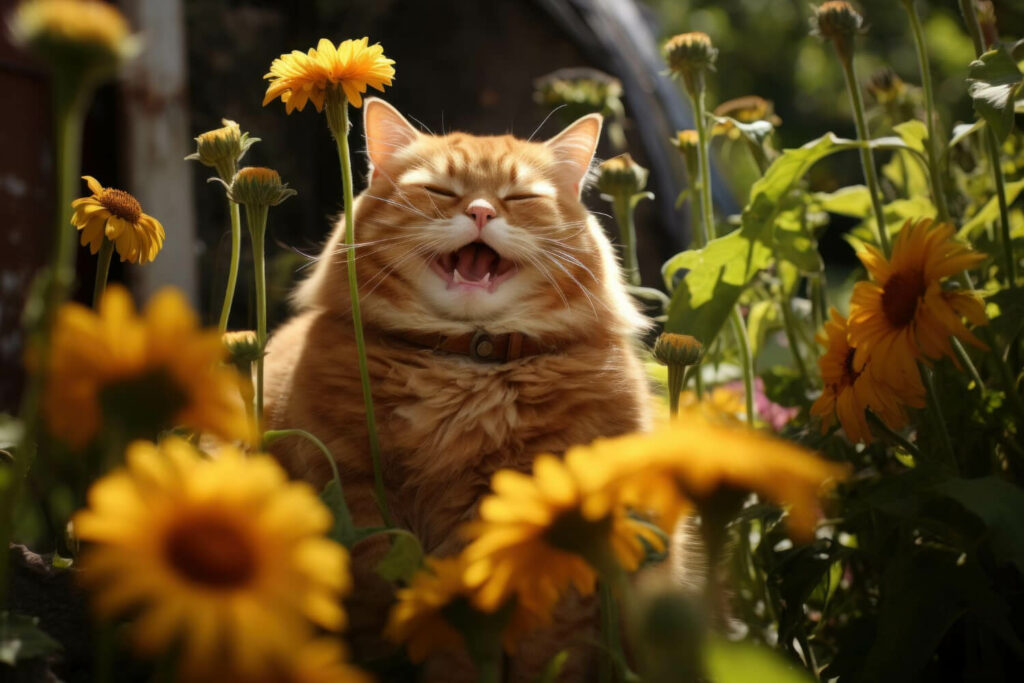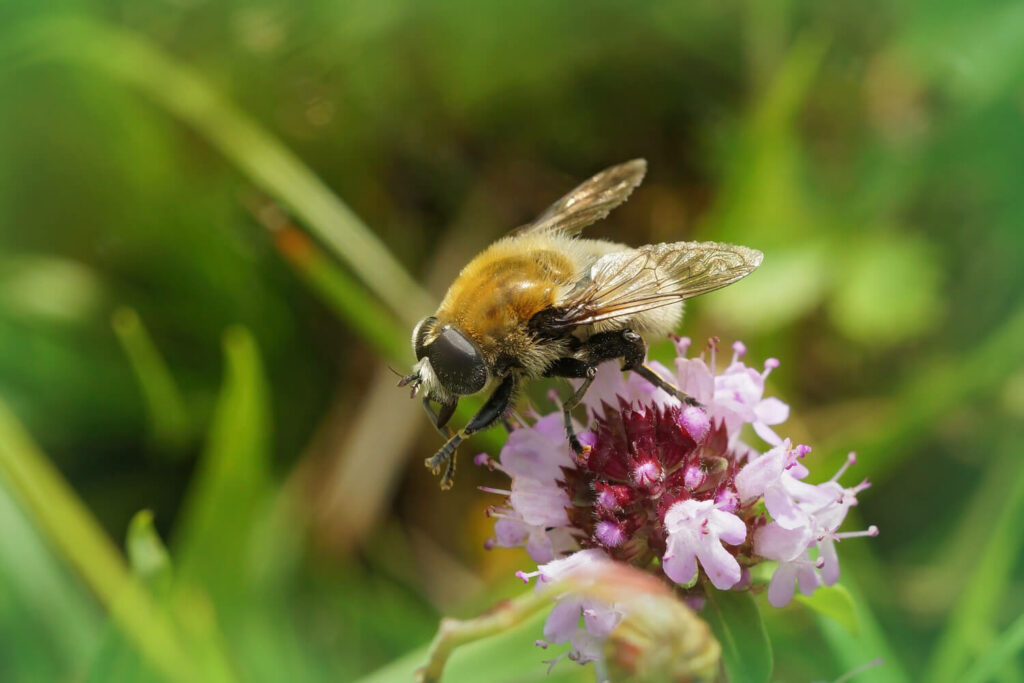Signs, Symptoms, and Treatment for a Cat Stung by Bee
My cats have never been stung by bees, at least to my knowledge. But I know that my neighbour’s dog got stung by a bee and I saw his face get all bloated.
Does the same happen to cats? Does the cat stung by bee have the same reactions as dogs when they get stung by bees?
I was curious, and the answer is yes. I mean both cats and dogs are different from one another, but they do show the same signs of bee stings as we humans do.
Key Takeaways:
- Immediate Reactions: Cats may meow loudly, paw at the sting spot, and show swelling and redness.
- Severe Symptoms: Watch for signs of allergic reactions such as difficulty breathing, facial swelling, and hives.
- First Aid: Remove the stinger carefully, apply a cold compress, and prevent scratching using an Elizabethan collar.
- Emergency Care: Seek immediate veterinary attention if your cat shows signs of severe allergic reaction.
- Prevention: Keep cats indoors during peak bee activity and avoid planting bee-attracting flowers in areas where your cat plays.
- Signs of a Cat Stung by Bee
- Symptoms of a Cat Stung by Bee
- What to Do if Cat Gets Stung by Bee
- FAQ
- What happens if a cat gets stung by a bee?
- What should I do if I suspect my cat has been stung by a bee?
- Should I apply any home remedies to the sting site?
- How can I tell if my cat is having an allergic reaction to the bee sting?
- What should I do if my cat is having trouble breathing after being stung by a bee?
- How can I prevent my cat from getting stung by bees in the future?
Signs of a Cat Stung by Bee
Curious cats often find themselves on the wrong end of a bee sting. While most stings cause only mild discomfort, it’s important to be aware of the signs and symptoms your cat might develop so you can help your cat feel better.
Right After the Sting:
Cats typically react immediately to a bee sting. Every cat reacts differently, but stay cautious because;
1. Your cat might start meowing loudly.
Your cat might start yowling or meowing loudly in pain. The sting can be quite startling and uncomfortable for them as much as it is for us.

2. They could be pawing at the sting spot.
They may instinctively paw at the stung area. This could be an attempt to remove the stinger if it’s still present, or simply to soothe the discomfort.
3. Look out for swelling and redness where they got stung.
Look closely for localized swelling and redness around the sting site. This is a common reaction to the bee’s venom and may appear within minutes.
Later Reactions:
As time passes, some additional signs might become apparent:
1. Your cat might seem more restless or grumpy than usual.
Your cat might become more restless or irritable than usual. The discomfort and itchiness caused by the sting can make them feel agitated.
2. They might lose interest in food.
In some cases, the pain or discomfort might lead to a temporary loss of interest in food. This is usually nothing to worry about unless it persists for several days.
3. If things get severe, they could struggle to breathe
It’s important to note that in severe allergic reactions, swelling and inflammation can affect the airways, causing labored breathing. This is a serious indication that has to be addressed by a veterinarian right away. If you notice any difficulty breathing, excessive drooling, or widespread hives, take your cat to the vet right away.
Symptoms of a Cat Stung by Bee
A bee sting can affect your cat in two main ways: localized symptoms around the sting site and potential effects on the entire body.

What you might notice near the sting:
- There’s likely pain and discomfort where they get stung. The most immediate sign is likely pain and discomfort at the sting site. Your cat might yowl or meow loudly, a clear indication of their distress.
- You might see swelling and redness. Look closely for localized swelling and redness around the sting. This is a common reaction to the bee’s venom and usually appears within minutes.
How the sting might affect their whole body:
While most stings cause only mild discomfort, in some cases, a bee sting can trigger a more widespread reaction in your cat’s body. Look out for these signs:
They could develop hives or a rash.
The venom can cause itchy welts or a raised rash that appears beyond the sting site.
2. Their face might puff up.
In severe reactions, swelling can spread to the face, making it appear puffy. This can be particularly concerning if it affects their eyes or breathing.
3. In serious cases, they might struggle to breathe or even collapse.
In the most serious cases, a severe allergic reaction (anaphylaxis) can occur. This can lead to labored breathing, excessive drooling, and even collapse. If you notice any of these signs, seek immediate veterinary attention.
What to Do if Cat Gets Stung by Bee
If your cat gets stung by a bee, here’s what you can do to help them feel better:
1. Remove the Stinger (if present): A bee’s stinger has a barbed end that can remain lodged in your cat’s skin. If you see it, carefully scrape it off with a flat object like a credit card. Avoid squeezing the stinger, as this can push more venom into the wound.
2. Soothe the Sting Site: The sting will likely cause some pain and discomfort. Apply a cold compress wrapped in a thin towel to the affected area for short intervals (10 minutes on, 10 minutes off) to reduce swelling and inflammation. Do not apply ice directly as it can damage the skin.
3. Prevent Scratching: The sting will likely itch, and your cat might try to scratch at it. This may make the discomfort worse and raise the possibility of infection. Consider using an Elizabethan collar (cone) to prevent them from reaching the sting site.
4. Monitor Your Cat: Keep an eye on your cat for any signs of a severe allergic reaction, which can include difficulty breathing, excessive drooling, vomiting, hives, or facial swelling. If you notice any of the mentioned signs, take your cat to the veterinarian immediately.
5. When in Doubt, Seek Veterinary Help: If you’re unsure about the severity of the sting or your cat’s reaction, it’s always best to err on the side of caution and consult your veterinarian. They can provide proper treatment and ensure your feline friend recovers comfortably.

FAQ
What happens if a cat gets stung by a bee?
When a cat gets stung by a bee, it can cause immediate reactions such as vocalization, pawing at the sting spot, and swelling and redness at the site of the sting. In some cases, the cat may also experience later reactions like increased restlessness, loss of appetite, or difficulty breathing.
What should I do if I suspect my cat has been stung by a bee?
If you suspect your cat has been stung by a bee, the first step is to assess the situation calmly. Look for signs such as meowing loudly, pawing at the sting spot, or swelling and redness at the site of the sting. If you notice any of these signs, try to keep your cat calm and remove any stinger if visible. Contact your veterinarian for guidance on further steps to take.
Should I apply any home remedies to the sting site?
Applying a cold compress or ice pack wrapped in a towel to the sting site can help reduce swelling and alleviate discomfort. However, it’s essential to consult with your veterinarian before attempting any home remedies to ensure they are safe and appropriate for your cat’s specific situation.
How can I tell if my cat is having an allergic reaction to the bee sting?
Signs of an allergic reaction in cats include hives or rash, facial swelling, difficulty breathing, weakness, or collapse. If you observe any of these symptoms, seek immediate veterinary care for your cat.
What should I do if my cat is having trouble breathing after being stung by a bee?
If your cat is struggling to breathe after being stung by a bee, it is a medical emergency. Contact your veterinarian or the nearest emergency veterinary clinic immediately for guidance and transport your cat to the clinic as soon as possible.
How can I prevent my cat from getting stung by bees in the future?
To reduce the risk of bee stings, consider keeping your cat indoors during peak bee activity times, such as sunny afternoons. Avoid planting bee-attracting flowers in areas where your cat spends time outdoors, and use deterrents or barriers to keep bees away from your cat’s favorite hangout spots.







